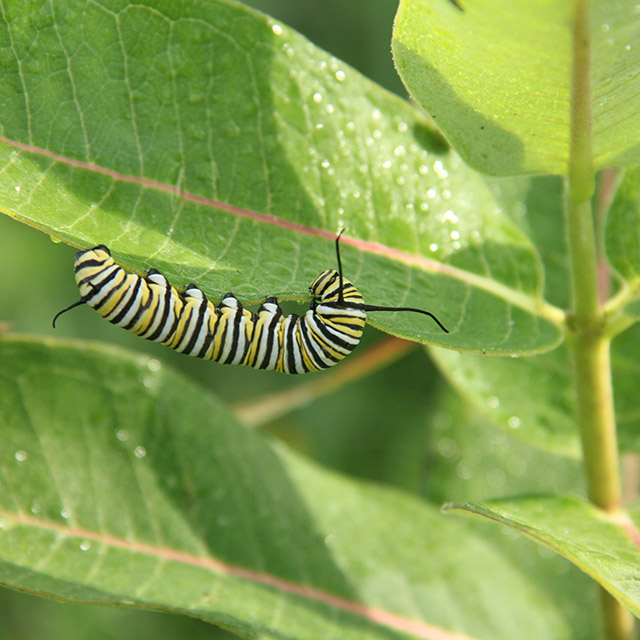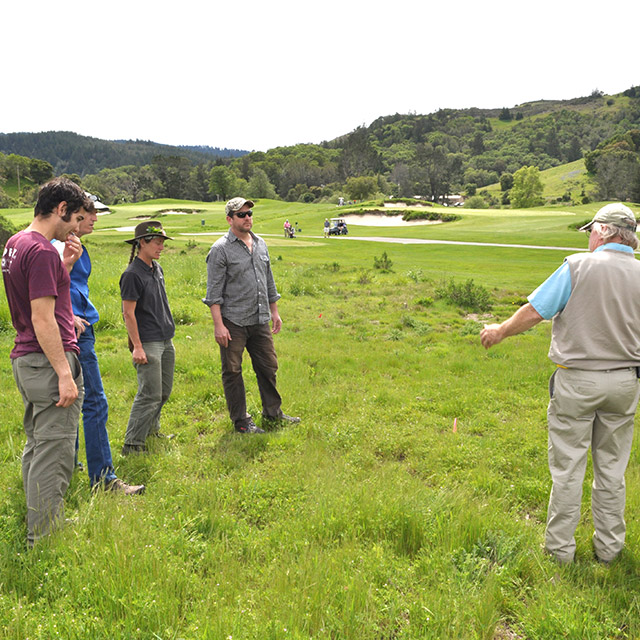This is not your Grandpa’s golf course.
Today, updated management practices use integrated pest control management instead of chemicals to control weeds, attention is given to reducing water usage and butterfly preserves are thriving amid the golfers.
Audubon International and the Environmental Defense Fund have partnered to create Monarchs in the Rough, a program that creates monarch butterfly habitat in out-of-play areas on golf courses across North America.
The “rough” refers to less-maintained areas in and around golf courses.
Launched in 2018, the Monarch in the Rough initiative includes 650 golf courses, creating more than 900 acres of butterfly habitat that stretch from Canada to Mexico.
Golf properties occupy 2.3 million acres across the country, but use only 30 percent of that area for the actual game, giving them ample opportunities to establish plantings for butterflies, said Marcus Gray of Audubon International, Monarch in the Rough program manager.
“We’re working hard to change the image of golf courses, as they are often the last remaining open space in many communities,” Gray said. “We need as much habitat for butterflies as we can get, and this is a concerted effort to save and protect these butterflies.”
Situation dire
Within a generation, the situation for the monarchs had become dire.
“The monarch population has declined by 90 percent in the past 20 years and that loss is linked to the loss in habitat,” said Christine Kane, CEO of Audubon International. “The reasons range from housing and commercial development to changes in agriculture production. Where land couldn’t be plowed earlier, it can be plowed now.
“Milkweed was also viewed as a weed, but now we understand the important role it plays for the monarch,” Kane said.
The Environmental Defense Fund and Audubon International were both trying to find ways to improve the monarch’s situation and give the well-known black-and-orange butterflies a future.
“We created the program together,” Kane said. We realized that golf is an industry that requires lots of land, and because only about 30 percent of the land is used for playing golf, the rest of the acreage that is ‘out-of-play’ could support habitat for butterflies.”
The program was initially funded by a combined grant for $150,000 from the National Fish and Wildlife Foundation and $100,000 from the U.S. Golf Association, with additional matching funds from Audubon International and partners.
A pilot program began in California in 2017. Free milkweed seed was distributed nationwide in 2018, and the program took off in August of 2018 when the grant was received.
Audubon International began recruiting golf courses, asking those courses located in the monarch’s fly-way from Canada to Mexico, to participate.
“It comes with a pollinator mix of seeds to help support the plot and help other types of butterflies,” Kane said.
Big enough to eat
The milkweed seeds are generally planted in fall and will take a season to mature. After one season, the plants will be big enough for a monarch caterpillar to eat, Gray said.
The milkweed plant is the only food a monarch caterpillar will eat, Gray said.
Adult monarchs lay eggs on the milkweed, which will form into a caterpillar before becoming a chrysalis. Adult monarchs also drink nectar from the milkweeds, making the plants important to the monarchs throughout their life cycle.
A number of golf courses in the south-central Pennsylvania area are participating in Monarchs in the Rough, including the Bent Creek Country Club Course in Manheim Township, Lancaster County; the Lebanon Country Club in North Cornwall Township, Lebanon County; the Allentown Municipal Golf Course, Trexler Park, Lehigh County; the Coatesville Country Club, West Caln Township, Chester County; and the Mountain Valley Golf Course in Ryan Township, Schuylkill County.
“The novel thing about the golf courses is they have the staff and the budget to maintain these habitats in the future,” Gray said. “I look at these golf courses as a network of reserves for the butterflies.”
Even though their numbers have declined since the 1980s, Gray is hopeful that projects such as Monarchs in the Rough will help their populations to increase.
“We’re just trying to get more habitat in the landscape,” Gray said.
Save and protect
Doing butterfly stewardship work can be rewarding, but it can also be a battle to save and protect the delicate creatures.
“Conservation work has been going on in earnest for the past five years,” Gray said. “We get reports from golf courses that they are seeing more monarchs, but that’s difficult to tell, and we have a long way to go yet.
“But with the golf courses, we’re getting a whole new sector engaged, and they’re jumping in with both feet,” Gray said. “They are actually scaling up and planting more milkweed on their own.”
For home gardeners who want to help sustain the butterflies, Gray said the monarchs need to feed on late-blooming plants, such as asters or goldenrod.
Adult monarchs like zinnias, verbena, coneflowers, butterfly bush blooms and blazing star, along with many other perennials, he said.
Homeowners can find plants and seeds for monarchs at native plant nurseries or seed companies, and in this area, at vendors such as Ernst Seeds in Meadville, Crawford County; Bowman’s Hill Wildflower Preserve Spring Wildflower Gala, in New Hope, Bucks County; and Longwood Gardens, Kennett Square, Chester County.
Some local wildlife conservancies may be able to help gardeners find seeds or plants to help the monarchs and other pollinators.
Audubon International is a partner of the Monarch Joint Venture, the largest collaborative in the world to arrest the decline of the monarch.
Check out the hashtag #MonarchsInTheRough on Twitter or visit their Facebook page for updates from the field: www.facebook.com/MonarchsInTheRough.
Contact Marylouise Sholly: specialsections@readingeagle.com.











